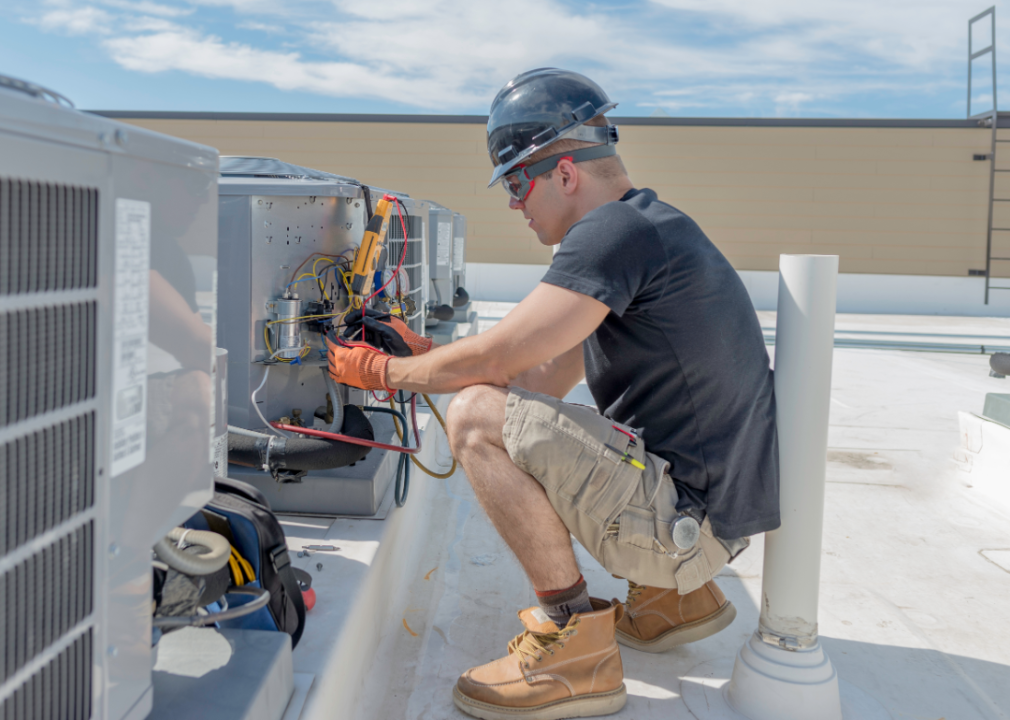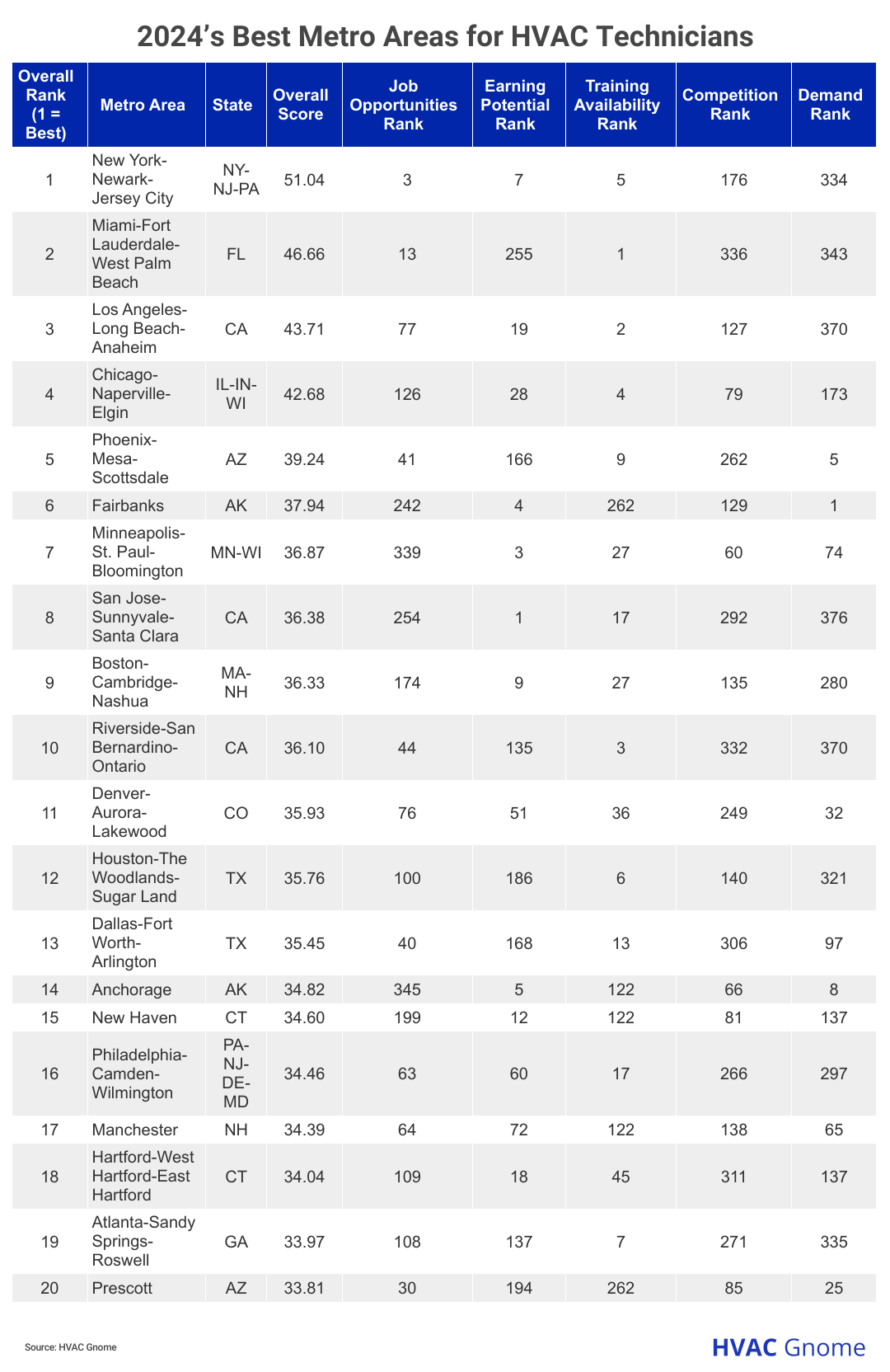20 metro areas with the most income and work opportunities for HVAC technicians

Canva
20 metro areas with the most income and work opportunities for HVAC technicians
HVAC tech checking on condensing unit on roof
The heating, ventilation, and air conditioning (HVAC) industry is heating up in parts of the U.S. while a shortage of technicians is cooling down others.
So, which metro areas offer the best career opportunities for HVAC specialists?
To better identify the cities that have the most opportunities for professionals working in the field, HVAC Gnome ranked 2024’s best metro areas offering the most training and income opportunities for current and aspiring HVAC technicians. The analysis compared over 380 of the biggest U.S. metros based on five categories. The number of HVAC employers and jobs, average hourly wages, and access to training programs, among eight total metrics, were also considered.
To learn how metros were ranked, see the methodology.
![]()

HVAC Gnome
A closer look at the top 5 metros for HVAC technicians
table showing top 20 best metro areas for HVAC technicians
1: New York-Newark-Jersey City, NY-NJ-PA | Overall Score: 51.04
- Projected Industry Growth in State (2020-2030): 11.27% | Rank: 175
- Number of HVAC Employers: 7,892 | Rank: 1
- Average Hourly Wage for HVAC Technicians: $35.01 | Rank: 7
- Number of Local HVAC Training Programs: 14 | Rank: 5
- Competitors (HVAC Technicians) per 10,000 Households: 26 | Rank: 176
2: Miami-Fort Lauderdale-West Palm Beach, FL | Overall Score: 46.66
- Projected Industry Growth in State (2020-2030): 15.4% | Rank: 88 (tie)
- Number of HVAC Employers: 2,469 | Rank: 4
- HVAC Jobs per 1,000 Total Jobs: 4 | Rank: 67
- Number of Local HVAC Training Programs: 32 | Rank: 1
- Average Number of Extremely Hot Days: 73 | Rank: 87
3: Los Angeles-Long Beach-Anaheim, CA | Overall Score: 43.71
- Projected Industry Growth in State (2020-2030): 13.8% | Rank: 117 (tie)
- Number of HVAC Employers: 3,576 | Rank: 2
- Average Hourly Wage for HVAC Technicians: $33.02 | Rank: 19
- Number of Local HVAC Training Programs: 20 | Rank: 2
- Competitors (HVAC Technicians) per 10,000 Households: 24 | Rank: 127
4: Chicago-Naperville-Elgin, IL-IN-WI | Overall Score: 42.68
- Number of HVAC Employers: 3,133 | Rank: 3
- Average Hourly Wage for HVAC Technicians: $31.47 | Rank: 28
- Number of Local HVAC Training Programs: 16 | Rank: 4
- Competitors (HVAC Technicians) per 10,000 Households: 21 | Rank: 79
- Average Number of Extremely Cold Days: 127 | Rank: 102
5: Phoenix-Mesa-Scottsdale, AZ | Overall Score: 39.24
- Projected Industry Growth in State (2020-2030): 30.6% | Rank: 14 (tie)
- Number of HVAC Employers: 1,600 | Rank: 11
- Average Hourly Wage for HVAC Technicians: $26.40 | Rank: 166
- Number of Local HVAC Training Programs: 11 | Rank: 9
- Average Number of Extremely Hot Days: 169 | Rank: 1
The upshot
Metros from disparate regions — such as New York (No. 1), Minneapolis (No. 7), and Anchorage, Alaska (No. 14) — land among the top 10 with the highest average hourly wages for HVAC technicians.
Chilly states like Alaska, Massachusetts, and Montana finish in the top 100 of our ranking largely due to high earning potential and long periods of extreme weather, which can take a toll on HVAC systems. Metros in these states have average hourly wages above $25, with techs in Fairbanks, Alaska (No. 6), making over $36 on average. The national average was $27.95 at the time of writing, according to Indeed.
Ten Florida, six Arizona, and three Nevada metros score in the top 100 due to numerous job opportunities. The HVAC industry is projected to grow between 15.4% and 30.6% in these warm-weather states by 2030.
Southeastern metros, particularly in West Virginia and Georgia, land at the bottom of our ranking with fewer job opportunities and low average wages. HVAC workers in Parkersburg-Vienna, West Virginia (No. 383), bring home the lowest average wage — $18.51 per hour — in our ranking.
Behind the ranking
First, this analysis determined the factors (metrics) that are most relevant to rank the Best Metro Areas for HVAC Technicians. Weight was then assigned to each factor based on its importance and grouped those factors into five categories: Job Opportunities, Earning Potential, Training Availability, Competition, and Demand. More about the categories, factors, and their weights can be found in the methodology.
For each of the 394 biggest U.S. Metropolitan Statistical Areas (or simply “metros”), data was gathered on each factor from CareerOneStop, Census Business Builder, National Oceanic and Atmospheric Administration, Projections Central, and U.S. Bureau of Labor Statistics. We eliminated 11 metros lacking sufficient data in a single category, resulting in a final sample size of 383 metros.
Finally, scores were calculated (out of 100 points) for each metro to determine its rank in each factor, each category, and overall. A metro’s overall score is the average of its scores across all factors and categories. The highest overall score ranked “best” (No. 1) and the lowest “worst” (No. 383). The “worst” among individual factors may not be No. 383 due to ties.
Final thoughts: Industry outlook
The U.S. has been struggling to recover from a widespread skilled labor shortage since 2020. Meanwhile, demand grows for the HVAC industry with an average of 37,700 projected HVAC job openings each year between 2022 and 2032.
With net-zero emissions goals on the horizon — meaning stricter HVAC standards and efficiency requirements — many companies and residences will be upgrading their HVAC systems to comply, creating an even greater need for HVAC workers. The stress of heatwaves and record temperatures will only further exacerbate HVAC systems and the need for HVAC technicians to repair and replace them.
The average HVAC pro is reaching retirement age in the coming decade. Luckily, interest in trade careers is growing. Community colleges with vocational programs saw an enrollment increase of 16% in the fall 2023 semester.
Increased interest and access to HVAC apprenticeships, free training programs, and even virtual reality HVAC training are aimed at advancing the industry as demand continues to grow.
This story was produced by HVAC Gnome and reviewed and distributed by Stacker Media.
